Monday, October 12, 2009
Western Australia to Protect Whales with Marine Park
 The state government of Western Australia is creating a marine park to protect and manage a key nursery of the world's largest humpback whale population.
The state government of Western Australia is creating a marine park to protect and manage a key nursery of the world's largest humpback whale population. The marine park is to be at Camden Sound, about 400km north of Broome, protecting its pristine marine environment for generations to come.
Allowing for consultation, including a public comment period of three months, a marine park could be established by mid-2010.
Environment Minister Donna Faragher said Camden Sound was the biggest calving area for humpback whales in the southern hemisphere.
"More than 1,000 humpback whales can be found in the Camden Sound ‘maternity ward' during the calving season," she said.
Mrs Faragher added "They are part of the biggest population of humpback whales in the world - numbering about 22,000 - that migrate from Antarctica every year to give birth in the waters off the north of our State.
"Camden Sound is also rich in other marine life, from coral reefs and mangrove forests to turtles and dugongs.
Humpbacks have been protected from whaling in the southern hemisphere since 1963, when numbers in Western Australia fell to fewer than a thousand. Their numbers are recovering at a remarkable 10 per cent each year.
Found in oceans around the world, humpback whales typically migrate up to 25,000 kilometres each year. They feed only in summer, in polar waters, and migrate to warmer waters to breed and give birth in the winter. During the winter, humpbacks fast and live off their fat reserves.
Further Reading:
Scientists discover massive humpback whale nursery off WA coast
What do you think of this news item? Join a discussion.
Labels: Australia, SCUBA News, whale and dolphins
Friday, October 09, 2009
Albatrosses feed with Killer Whales
Scientists have recorded the first observations of how albatrosses feed alongside marine mammals at sea.
A miniature digital camera was attached to the backs of four black-browed albatrosses (Thalassarche melanophrys). Results are published online this week in the open-access journal PLoS ONE.
Albatrosses fly many hundreds of kilometers across the open ocean to find and feed upon their prey. Despite the growing number of studies concerning their foraging behaviour, relatively little is known about how albatrosses actually locate their prey. The still images recorded from the cameras showed that some albatrosses actively followed a killer whale (Orcinus orca), possibly to feed on food scraps left by this diving predator. The camera images together with the depth profiles showed that the birds dived only occasionally, but that they actively dived when other birds or the killer whale were present. This association with diving predators or other birds may partially explain how albatrosses find their prey more efficiently in the apparently ‘featureless’ ocean, with a minimal requirement for energetically costly diving or landing activities.
The camera, developed by the National Institute for Polar Research in Tokyo, is removed when the albatross returns to its breeding ground after foraging trips. It is small and weighs 82g. Although the camera slightly changes the aerodynamic shape of the albatross, it didn’t affect the breeding success of the study birds.
Dr Richard Phillips from British Antarctic Survey (BAS) says, “These images are really interesting. They show us that albatrosses associate with marine mammals in the same way as tropical seabirds often do with tuna. In both cases the prey (usually fish) are directed to the surface and then it’s easy hunting for the birds."
The study took place at the breeding colony of black-browed albatrosses at Bird Island, South Georgia in January 2009, as part of a UK-Japan International Polar Year 2007-9 project.
A miniature digital camera was attached to the backs of four black-browed albatrosses (Thalassarche melanophrys). Results are published online this week in the open-access journal PLoS ONE.
Albatrosses fly many hundreds of kilometers across the open ocean to find and feed upon their prey. Despite the growing number of studies concerning their foraging behaviour, relatively little is known about how albatrosses actually locate their prey. The still images recorded from the cameras showed that some albatrosses actively followed a killer whale (Orcinus orca), possibly to feed on food scraps left by this diving predator. The camera images together with the depth profiles showed that the birds dived only occasionally, but that they actively dived when other birds or the killer whale were present. This association with diving predators or other birds may partially explain how albatrosses find their prey more efficiently in the apparently ‘featureless’ ocean, with a minimal requirement for energetically costly diving or landing activities.
The camera, developed by the National Institute for Polar Research in Tokyo, is removed when the albatross returns to its breeding ground after foraging trips. It is small and weighs 82g. Although the camera slightly changes the aerodynamic shape of the albatross, it didn’t affect the breeding success of the study birds.
Dr Richard Phillips from British Antarctic Survey (BAS) says, “These images are really interesting. They show us that albatrosses associate with marine mammals in the same way as tropical seabirds often do with tuna. In both cases the prey (usually fish) are directed to the surface and then it’s easy hunting for the birds."
The study took place at the breeding colony of black-browed albatrosses at Bird Island, South Georgia in January 2009, as part of a UK-Japan International Polar Year 2007-9 project.
What do you think of this news item? Join a discussion.
Labels: research, SCUBA News, whale and dolphins
Creature of the Month: Plumose Anemone
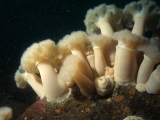 Plumose anemones (Metridium senile) occur in large numbers in good diving areas in temperate waters. They comprise a tall, smooth column topped with a crown of feathery tentacles. When they contact they look like swirly blobs, as can be seen in our photograph.
Plumose anemones (Metridium senile) occur in large numbers in good diving areas in temperate waters. They comprise a tall, smooth column topped with a crown of feathery tentacles. When they contact they look like swirly blobs, as can be seen in our photograph.Individuals may be white, orange, green or blue in colour. They grow up to 30 cm tall and 15 cm across at the base. They like areas with currents so tend to live on prominent pieces of wrecks or on rocky pinnacles.
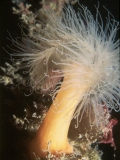 With fine, delicate tentacles they are unsuited to capturing large animals like fish. Instead they specialise in smaller prey such as small planktonic crustaceans. The anemone's columnar body is narrower just below the tentacles. A current will bend the stalk at this point and expose the tentacles broadside to the flow in the best position for feeding on suspended matter.
With fine, delicate tentacles they are unsuited to capturing large animals like fish. Instead they specialise in smaller prey such as small planktonic crustaceans. The anemone's columnar body is narrower just below the tentacles. A current will bend the stalk at this point and expose the tentacles broadside to the flow in the best position for feeding on suspended matter.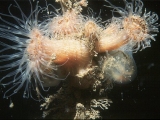 The Plumose anemone occurs from the Bay of Biscay (North of Spain) to Scandinavia in the northeast Atlantic, and on the west and east coasts of North America. It is unknown from the western basin of the Mediterranean but has been seen in the Adriatic, where it is believed to have been introduced. It has also been seen in Table Bay Harbour in South Africa where it was probably introduced from Europe.
The Plumose anemone occurs from the Bay of Biscay (North of Spain) to Scandinavia in the northeast Atlantic, and on the west and east coasts of North America. It is unknown from the western basin of the Mediterranean but has been seen in the Adriatic, where it is believed to have been introduced. It has also been seen in Table Bay Harbour in South Africa where it was probably introduced from Europe.
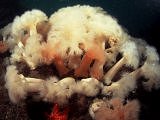
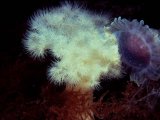
Further Reading:
Great British Marine Animals, by Paul Naylor
Ask Nature
What do you think of this news item? Join a discussion.
Labels: environment, Europe, marine biology, SCUBA diving, SCUBA News, SCUBA Travel, UK